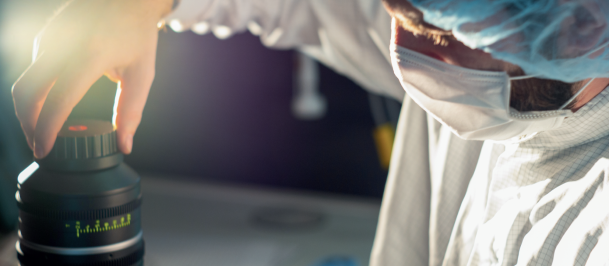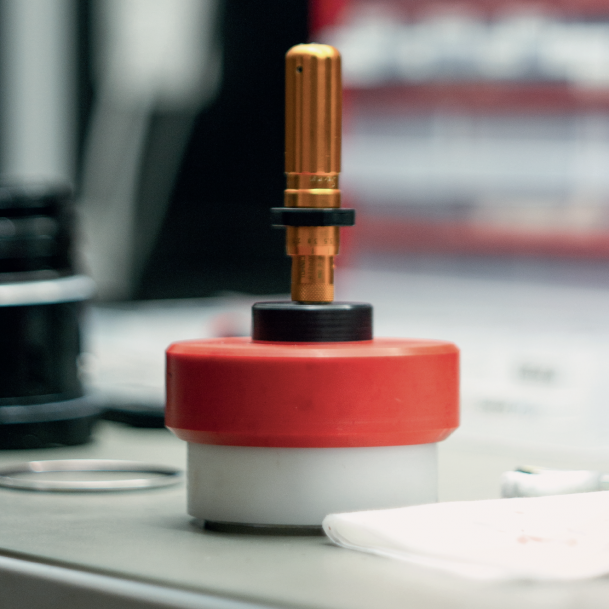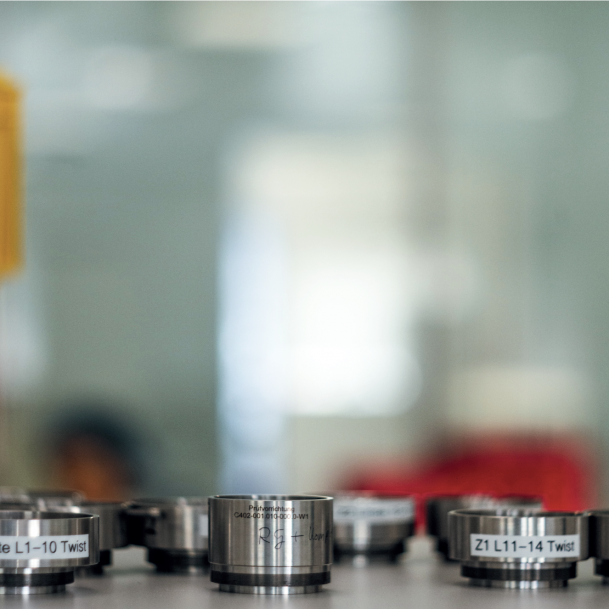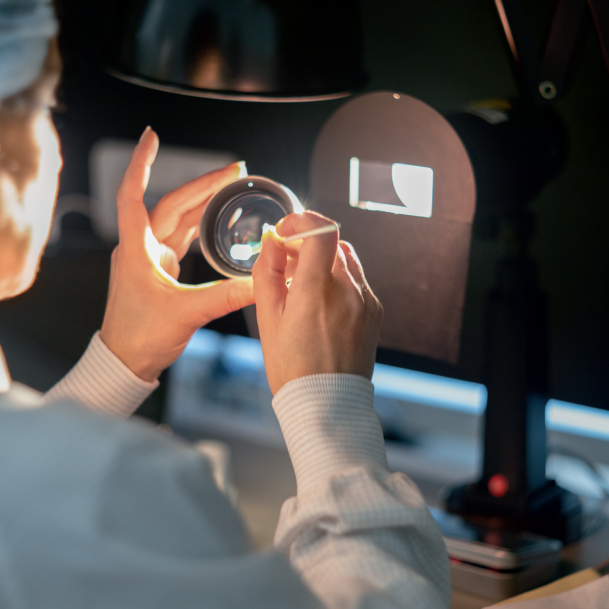The Heart Beats Red
At Leitz-Park two red dots are now shining. One of them marks the Leica Camera headquarters. Diagonally opposite and in direct eye contact, the Leitz logo is emblazoned on one of the new buildings. We were allowed to take a look behind the façade.
When Leitz-Park III was inaugurated on June 15, 2018, one could hear the faint clinking of glasses in the building with house no. 2. Because this was the day when the employees of former CW Sonderoptic were celebrating three events at once: successfully moving houses with the company, their company’s 10 years existence, and the official “hour of rebirth” of the Leitz brand. For all of them, so much is clear when visiting the company, this was much more than just a moving day with anniversary and a change of the company’s name.
A young team and their pride and joy
On the upper floor of the building where the Ernst Leitz Wetzlar GmbH has had its home for a year now, the management team is sitting around a big conference table showcasing an assortment of their own optics. An impressive picture: the young team and their pride and joy, the cine lenses in dark and plain elegance. Looking around reveals that the fascination is written in the faces of each and everybody at the table. Laura Kaufmann, Executive Officer for Marketing and HR, is in charge of the worldwide representation of the brand; Managing Director Carsten Schuckenböhmer conducts the affairs and finances of the company; Dr. Aurelian Dodoc has been responsible for development and manufacture of these stellar lenses as Chief Technology Officer for more than five years; Rainer Hercher, Chief Sales and Business Development Officer, sells the lenses around the globe, and as COO heading the departments procurement, logistics, and planning, Raimund Bayer sees to it that everything in the company is running smoothly.
In 2008, Dr. Andreas Kaufmann, chairman of the supervisory board of Leica Camera AG, founded CW Sonderoptic GmbH as an autonomous company. The target: to transfer the extraordinary image quality of Leica photography to the moving pictures and give movie makers new creative spheres to explore. Within a very short time, this target was accomplished with the Leica SUMMILUX-C lenses. Additional lenses made by the company continue to set standards. The development and production of these sophisticated optical elements of the highest quality put the company globally on top of the industry for cinematographic special optics in the prime segment.
Cine lenses, that range among the best of the world
In the past years, these lenses have been used for shooting numerous films, such as “Birdman”, “Planet of the Apes: Revolution“, “Gone Girl“, or “Green Book“ which won an Academy Award for Best Picture this year. In fact, even the SUMMILUX-C already received the greatest blessing from the Academy of Motion Picture Arts and Sciences: That was in 2015, when the developers won the “Scientific and Engineering Award”. It may not have been an “Oscar” but the desirable Academy Plaque which is the highest award for technical products and innovation in the movie industry.
Renowned camera people all over the world appreciate the cine lenses from Wetzlar, because they facilitate the work on set with their high lens speed, soft sharpness gradient, compact design, and their low weight. These advantages distinguish the two product lines SUMMICRON-C und SUMMILUX-C as well as the M 0.8 and THALIA or the completely new line of lenses LEITZ PRIME and LEITZ ZOOM which were recently presented at the NAB (National Association of Broadcasters) trade show in Las Vegas for the first time.
“These lenses range among the best of the world with regard to pictorial quality, imaging performance and excellence,” managing director Carsten Schuckenböhmer explains. And Dr. Aurelian Dodoc adds: “Vast knowledge and expertise, great diligence and also a lot of high-class workmanship went into it.” When the developer starts getting enthusiastic about the brand and the products, it does not only sound convincing but also lends a lot of credence to it. He is wearing the red dot on his lapel but he also carries it in his heart. And it seems that the revival of the Leitz brand has made this heart pound even stronger.
Leitz outside – Leitz inside
For in the summer of 2018, when the company changed its name, they became Ernst Leitz Wetzlar GmbH. Now, the name in the red dot on the products does no longer read Leica but Leitz. Now, the brand-new development of the lenses LEITZ PRIME and LEITZ ZOOM establishes a direct connection between the company, the brand, and the product. Dr. Dodoc is convinced: “From my point of view, this step followed some intrinsic necessity. Connecting the product to the company’s name is perceived positively from the outside, for sure. But what is more important is the growing identification with the company and the brand which I have observed among my colleagues.”
Needless to say, that the celebrated Leitz lenses are developed and assembled in Wetzlar. Lenses and components come from their own production or from qualified specialists in optics and precision mechanics, some of whom are located in the region. A great cleanroom area under excess pressure and with temperature regulation was set up for the assembly of the exceptional lenses in the new building on Leitz Park. “Dust-free work is of utmost importance," Carsten Schuckenböhmer points out. And the employees know very well that each and every step of the process has to be carried out with great diligence and care. Every hand movement counts, every detail is important.
Why this is so crucial is demonstrated in the completely darkened test room right beside the assembly station. All lenses without exception are tested here before they leave the company. The room is a kind of cinema hall with projector. A template with thousands of check marks is projected against the wall showing so-called “Siemens stars”, bar patterns, and format markers which allow reading the imaging quality with regard to sharpness, resolution, or distortion. “Our lenses have an image-resolving power of more than 200 line pairs per millimeter,” Dr. Aurelian Dodoc explains. “This is actually inconceivable. But if you consider that the biggest cinema halls have image sizes of up to 80 square meters, you will get an idea about the dimensions concerned.”
High-end products for outstanding artists
Compared to that the circle for which such technical specifications are relevant is rather small and distinguished. “However, it is not just the technical brilliance which delights our customers but most of all the emotional quality,” Rainer Hercher explains who worked as a cameraman himself. That’s why he knows: Each cameraman and each camerawoman choose a distinctive visual language, an individual form of expression, which are defined by color coordination and contrasts, by the quality of definition and focus, depending in equal measure on the interaction of camera, sensor, and lens. Even in the age of Computer-Generated Imagery (CGI), says Hercher, the quality of the lens is of extreme importance, for instance, in “compositing” where you need the highest resolution possible to integrate a computer-generated picture seamlessly into the pictorial reality.
“It doesn’t matter if the film technology is analogous or digital – there are always people behind it going about their work with an artistic approach. Their work lives from the variety in the means of expression,” managing director Carsten Schuckenböhmer points out, “choosing a suitable lens plays a crucial role in this process, and we provide artists with high-end products which allow them to give their creativity full scope.”
Additional Information:
www.leitz-cine.com



